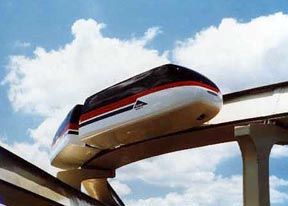System 21® Urban Monobeam System
 The System 21® "monobeam" is an elevated transit technology
under development by Charleston, South Carolina based FUTREX® Inc., a Delaware
"C" corporation founded in 1986. With financial assistance from the U.S.
Department of Commerce and a local utility, and engineering support from Battelle and
Frederic R. Harris, Inc., a $1.6 million one-quarter scale model of System 21 was
completed in 1996 and is operational in Charleston. South Carolina. Four
photos (200k) of this installation are provided.
The System 21® "monobeam" is an elevated transit technology
under development by Charleston, South Carolina based FUTREX® Inc., a Delaware
"C" corporation founded in 1986. With financial assistance from the U.S.
Department of Commerce and a local utility, and engineering support from Battelle and
Frederic R. Harris, Inc., a $1.6 million one-quarter scale model of System 21 was
completed in 1996 and is operational in Charleston. South Carolina. Four
photos (200k) of this installation are provided.
FUTREX next plans to build and test a full-scale 1.25 mile operational prototype to conclusively demonstrate ride quality, evacuation characteristics, low noise output, reliability, maintainability, ease of fabrication and installation and cost. The 36-month, $35 million program was expected to get underway in early 2000. $6.2 million in prototype funding has been earmarked by the U.S. DOT, with the remainder to come from the State of South Carolina, utility, strategic and private sources. The technology was to be ready for the market in 2002, at an all-inclusive capital cost estimated at $20-25 million per mile (supplier's margin would be additional). Operating cost we expected to be very competitive with most other fixed guideway technologies carrying comparable numbers of passengers/hour/direction.
The technology is unique in that two-way travel is possible using one slender, triangular guideway, typically 16-feet in the air, with vehicles riding along both sides of the monobeam via a unique cantilevered suspension configuration. The compact, modular nature of the system will make System 21 much easier to install in urban areas where space is at a premium. Because components of the compact guideway and ancillary equipment are fabricated off-site, and then delivered and quickly installed, disruption to the community is very limited during construction. Once installed, the System 21 guideway is a visually pleasing, low intrusion structure. Stations can also be pre-fabricated off-site, or built in place to a client's specification. These characteristics contribute significantly to System 21's low cost and appeal. Because the pre-fabricated, compact System 21 is "portable", and can be dismantled, refurbished and relocated for a secondary market, it may be the first fully "leasable" transit system, making it all the more attractive to communities that heretofore could not afford the up-front cost of traditional fixed guideway systems.
Capacity of more than 20,000 passengers/hour/direction is possible using 28-foot, 52-passenger vehicles in varying train lengths (1-10 cars), operating at as little as 90 second headways. Initial maximum speed is 70 mph, with later development leading to speeds of 100 mph or more. Proven, modern train control technology will regulate the movement of trains, either under automated or operator-assisted scenarios. Wayside 750v DC traction power is converted on-board to supply one 3-phase AC, 100 hp motor for each of the vehicle's two main drive wheels.
Maximum grade capability is 10%, with the suspension configuration assuring adequate traction in all weather conditions. Climate tested components, and a triangular guideway and weather guards that are not conducive to the accumulation of ice and snow, will make System 21 ideal for all weather conditions in temperature ranges of -40 to +125 degrees F. A minimum turning radius of 90-feet horizontal and 300-feet vertical give System 21 superior maneuverability around tight turns and over most terrains. A compact and elegant switch design, based on a standard railroad switch with an active frog and very few moving parts, allows grade separated branching to form efficient transit networks.
As of September, 2003, no significant progress has been made in the System 21 development program. Congress earmarked $6.2 million from FTA Appropriations (FY 1998-$1.5M, FY 1999-$2.2M, and FY 2000-$2.5M) for the construction of a full-scale demonstration System 21 monobeam line linking the Charleston International Airport to the Charleston Coliseum/Convention Center. The preliminary cost estimate for the 1.2 miles system between the coliseum and convention center was approximately $35,000,000, and Congress expected the needed funds to be raised mostly from private sources. The FY 1998 earmark of 1.5 million was awarded to the Charleston Area Regional Transportation Authority (CARTA) and CARTA selected the Futrex monobeam system.
Subsequently, Futrex submitted bids to the Manila International Airport Authority to install their system at the airport. The initial deployment of the Monobeam could therefore be at the Manila International Airport at their own cost and not at Charleston with partial Federal funding as Congress intended. However, the Manila Airport project has not moved forward yet, so CARTA is waiting to see what Futrex does next and then will decide what to do with the other two earmarks.
More detail is available on-line at at www.futrexinc.com
For more information about System 21, contact FUTREX Inc. Senior Vice-President Tom Waldron, 5300 International Blvd., Suite 100, N. Charleston, SC, 29418 USA. Phone: 843-760-4500; fax: 843-760-4622; e-mail futrex-info@futrexinc.com. A technology review entitled The Future: A New Urban Transit System Stands a Chance of Getting People Out of their Cars has been published in Architectural Record, July, 1997, page 174. It is also available on-line .
Last modified: October 06, 2003